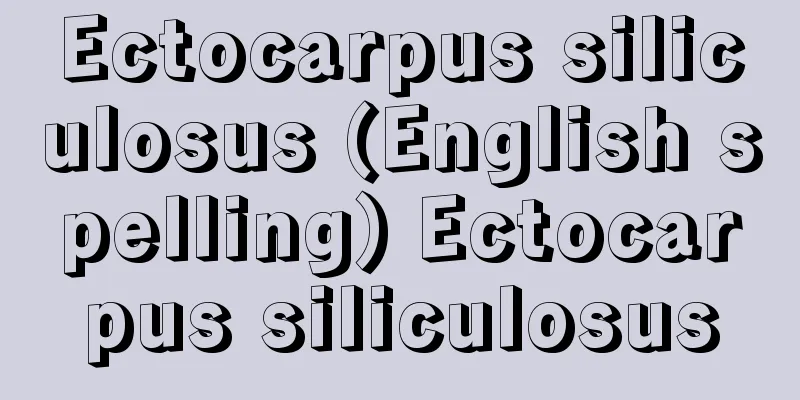Desmostylid - Desmostylid (English spelling)

|
A group (order) of extinct mammals known only from fossils, also known as the Desmostylians. The first fossil teeth discovered in 1888 were shaped like a bundle of small cylinders, so the scientific name Desmostylus was given to it, combining the Greek words desmos, meaning bundle, and styl, meaning column. Fossils are known from both sides of the North Pacific Ocean, from Oregon to California on the west coast of North America, and from Sakhalin to Hokkaido and Honshu in the Japanese archipelago on the east coast of Asia. They were excavated from strata dating to the Early and Middle Miocene epoch of the Tertiary Period (approximately 20 to 15 million years ago). Complete skeletons have been excavated in Sakhalin and Japan, with a hippopotamus-like body and thick legs that jut out to the sides like a crocodile, and are estimated to have been three meters long and weighed 200 to 300 kilograms. The motor skills of how it walked have also been reconstructed. Skeletal reconstructions include the Nagao reconstruction (1937), Kamei reconstruction (1970), and Inuzuka reconstruction (1984). In animal classification, it is included in the group called the Stylostrichidae, and is considered to be closely related to the Proboscidea (proboscidea) of elephants, the Sirenia (Campanula) of dugongs, the Hyrax (Rock hyrax) and the Hemipedia (hemipedia), which are only known from fossils. Unlike today, when Desmostylus lived, the Japanese archipelago was connected to the Asian continent. Based on plant and shell fossils found alongside the fossil bones of Desmostylus, it is believed that Desmostylus lived in mangrove forests along the coast in a warm climate. Based on the structure of their bodies, Desmostylus are thought to have been slow to move on land and to have mainly lived in the water, and there are various theories about their diet, such as seaweed, plants, or even worms and shellfish. However, based on the shape of their teeth, it is believed that they ground up and ate a variety of foods. One of the Desmostylus species is Paleoparadoxia , whose complete skeletons have been excavated in Mizunami, Gifu Prefecture, Tsuyama, Okayama Prefecture, and California, USA, and their reconstructed skeletons are on display at the respective museums. The ancestors of Desmostylus include Cornwallius and Behemotopus , which are found in strata from the Late Oligocene (approximately 27 to 24 million years ago), and Ashoroa , which was discovered in Ashoro, Hokkaido, from 29 million years ago. The phylogenetic evolution of Desmostylus species was elucidated by Inuzuka Norihisa, and their fossil specimens are on display together at the Ashoro Museum of Animal Science in Hokkaido. [Kamei Setsuo] "Restoration of Desmostylus by Inuzuka Norihisa (1984, Kaimeisha)" ▽ "Extinct Giant Beasts of Japan by Ijiri Shoji and Inuzuka Norihisa (1989, Tsukiji Shokan)" ▽ "Ancient Hokkaido - The Joys of Fossil Museums, revised edition by Kimura Hoichi (2007, Hokkaido Shimbun Press)" ▽ "Special Feature: Evolution of the Desmostylidae" (Bulletin of the Ashoro Museum of Animal Psacrocodiles, Vol. 1, 2000, Ashoro Museum of Animal Psacrocodiles)" [References] |From the middle Miocene period of the Neogene period in the Cenozoic Era, Esashi Town, Esashi District, Hokkaido (replica) Photo courtesy of the Geological Survey of Japan, National Institute of Advanced Industrial Science and Technology (GSJ F15156-1) Desmostylus skeleton Tokunaga and Iwasaki Specimen length: approx. 32cm Middle Miocene, Neogene Period, Cenozoic Era, Iwaki City, Fukushima Prefecture Photo courtesy of the Geological Survey of Japan, National Institute of Advanced Industrial Science and Technology (GSJ F2071) Desmostylus tooth Source: Shogakukan Encyclopedia Nipponica About Encyclopedia Nipponica Information | Legend |
|
化石でのみ知られる絶滅した哺乳(ほにゅう)動物の一グループ(目)、束柱類(そくちゅうるい)ともいう。1888年に最初に発見された歯の化石が、小さな円柱を束(たば)ねたような形をしていたので、ギリシア語の束ねるのデスモスdesmosと、柱のスチルstylとをあわせてデスモスチルスという学名がつけられた。 化石は、北太平洋の両岸から知られていて、北米の西岸ではオレゴンからカリフォルニア、アジアの東岸ではサハリンから日本列島の北海道・本州の各地から発見されている。それらは第三紀の中新世前・中期(約2000万~1500万年前ごろ)の地層から出土している。 サハリンと日本では全身の骨格が発掘されていて、カバのような胴体にワニのように横に張り出した太い四脚がつき、体長は3メートル、体重は200~300キログラムと推定されている。また、どのように歩行していたかという運動技能の復元もなされている。骨格復元は、長尾復元(1937)、亀井復元(1970)、犬塚復元(1984)などがある。動物分類では、束柱目というグループに含められ、ゾウの長鼻(ちょうび)目、ジュゴンなどの海牛(かいぎゅう)目、イワダヌキ(ハイラックス)の岩狸(いわだぬき)目や化石でのみ知られている重脚目のものに近縁とされている。 デスモスチルスがいたころの日本列島は、現在とは違って、アジア大陸に連なっていた。デスモスチルスの化石骨といっしょにみつかる植物や貝の化石から、デスモスチルスは温暖な気候のもと、海岸地帯のマングローブ林で生活していたと考えられている。デスモスチルス類は、体の構造から陸上での動きは鈍く、水中での生活が主であったとされ、食物としては海藻(かいそう)説、植物説またはゴカイや貝類説がある。しかし歯の形態からは、いろいろな食物をすり潰(つぶ)して食べていたことが推定されている。 デスモスチルスの仲間に、パレオパラドキシアPalaeoparadoxiaというものがあり、全身骨格は岐阜県瑞浪(みずなみ)市、岡山県津山市、アメリカのカリフォルニアで発掘されていて、それらの復元骨格がそれぞれの博物館で展示されている。デスモスチルスの先祖には、より古い漸新世後期(約2700万~2400万年前)の地層からのコルンワリウスCornwallius、ベヘモトプスBehemotopusが知られていて、さらに古い2900万年前のものとしては、北海道足寄(あしょろ)町で発見されたアショローアAshoroaが知られる。デスモスチルス類の系統進化の解明は犬塚則久によってされていて、それらの化石標本は、北海道の足寄動物化石博物館でまとまって展示されている。 [亀井節夫] 『犬塚則久著『デスモスチルスの復元』(1984・海鳴社)』▽『井尻正二・犬塚則久著『絶滅した日本の巨獣』(1989・築地書館)』▽『木村方一著『太古の北海道――化石博物館の楽しみ』改定版(2007・北海道新聞社)』▽『「特集・束柱類の進化」(『足寄動物化石博物館紀要』第1号所収・2000・足寄動物化石博物館)』 [参照項目] |新生代新第三紀中新世中期 北海道枝幸郡枝幸町産(レプリカ)写真提供/産業技術総合研究所地質調査総合センター(GSJ F15156-1)"> デスモスチルスの骨格 Tokunaga and Iwasaki 標本の横の長さ約32cm 新生代新第三紀中新世中期 福島県いわき市産写真提供/産業技術総合研究所地質調査総合センター(GSJ F2071)"> デスモスチルスの歯 出典 小学館 日本大百科全書(ニッポニカ)日本大百科全書(ニッポニカ)について 情報 | 凡例 |
<<: Tesla - Tesla (English spelling)
>>: Desman - Sorry (English spelling) desman
Recommend
Kalmyk Khanate
...In the 1240s, it came under the control of the...
Stage art - butai bijutsu (English spelling) stage art English
In performing arts such as theater, opera, and da...
Aspic - Aspic (English spelling)
Gelatin is added to meat juice to create a jelly-...
Yoshitaka Tsukamoto
1898-1980 A Buddhist history scholar and monk fro...
Raclette
…(5) Swiss cuisine and cuisine of Benelux countri...
Yatsuhashi-ryu
The name of a school of koto music. (1) It is used...
Yue (Spring and Autumn Period and Warring States Period) - Etsu
…It is said that this was the country to which Wu...
Registration - Touki
The entry of certain particulars in a public book...
Characidae; characins
A family of fish in the order Characidae. Most are...
Brothers-in-law
Two people who have made a promise and oath to int...
Oriental wrinkled-lipped bat (Tadarida insignis; Oriental wrinkled-lipped bat)
Order: Chiroptera, Family: Pteropidae. Forearm len...
Sudeten (English spelling)
Historical name for the area in northern Czech Re...
Otomi - Otomi
…The play was first performed at the Edo Nakamura...
Karafutoruri Shijimi (English name) Cranberry Blue
A butterfly belonging to the family Lycaenidae in...
anatman (English spelling)
...Because this perishes, that perishes." In...









